Zhao Yang
Hadamax Encoding: Elevating Performance in Model-Free Atari
May 21, 2025Abstract:Neural network architectures have a large impact in machine learning. In reinforcement learning, network architectures have remained notably simple, as changes often lead to small gains in performance. This work introduces a novel encoder architecture for pixel-based model-free reinforcement learning. The Hadamax (\textbf{Hada}mard \textbf{max}-pooling) encoder achieves state-of-the-art performance by max-pooling Hadamard products between GELU-activated parallel hidden layers. Based on the recent PQN algorithm, the Hadamax encoder achieves state-of-the-art model-free performance in the Atari-57 benchmark. Specifically, without applying any algorithmic hyperparameter modifications, Hadamax-PQN achieves an 80\% performance gain over vanilla PQN and significantly surpasses Rainbow-DQN. For reproducibility, the full code is available on \href{https://github.com/Jacobkooi/Hadamax}{GitHub}.
DualDiff: Dual-branch Diffusion Model for Autonomous Driving with Semantic Fusion
May 03, 2025Abstract:Accurate and high-fidelity driving scene reconstruction relies on fully leveraging scene information as conditioning. However, existing approaches, which primarily use 3D bounding boxes and binary maps for foreground and background control, fall short in capturing the complexity of the scene and integrating multi-modal information. In this paper, we propose DualDiff, a dual-branch conditional diffusion model designed to enhance multi-view driving scene generation. We introduce Occupancy Ray Sampling (ORS), a semantic-rich 3D representation, alongside numerical driving scene representation, for comprehensive foreground and background control. To improve cross-modal information integration, we propose a Semantic Fusion Attention (SFA) mechanism that aligns and fuses features across modalities. Furthermore, we design a foreground-aware masked (FGM) loss to enhance the generation of tiny objects. DualDiff achieves state-of-the-art performance in FID score, as well as consistently better results in downstream BEV segmentation and 3D object detection tasks.
DriVerse: Navigation World Model for Driving Simulation via Multimodal Trajectory Prompting and Motion Alignment
Apr 22, 2025



Abstract:This paper presents DriVerse, a generative model for simulating navigation-driven driving scenes from a single image and a future trajectory. Previous autonomous driving world models either directly feed the trajectory or discrete control signals into the generation pipeline, leading to poor alignment between the control inputs and the implicit features of the 2D base generative model, which results in low-fidelity video outputs. Some methods use coarse textual commands or discrete vehicle control signals, which lack the precision to guide fine-grained, trajectory-specific video generation, making them unsuitable for evaluating actual autonomous driving algorithms. DriVerse introduces explicit trajectory guidance in two complementary forms: it tokenizes trajectories into textual prompts using a predefined trend vocabulary for seamless language integration, and converts 3D trajectories into 2D spatial motion priors to enhance control over static content within the driving scene. To better handle dynamic objects, we further introduce a lightweight motion alignment module, which focuses on the inter-frame consistency of dynamic pixels, significantly enhancing the temporal coherence of moving elements over long sequences. With minimal training and no need for additional data, DriVerse outperforms specialized models on future video generation tasks across both the nuScenes and Waymo datasets. The code and models will be released to the public.
Exploiting Contextual Knowledge in LLMs through V-usable Information based Layer Enhancement
Apr 22, 2025Abstract:Large Language Models (LLMs) have demonstrated remarkable capabilities in various tasks, yet they often struggle with context-faithfulness generations that properly reflect contextual knowledge. While existing approaches focus on enhancing the decoding strategies, they ignore the fundamental mechanism of how contextual information is processed within LLMs' internal states. As a result, LLMs remain limited in their ability to fully leverage contextual knowledge. In this paper, we propose Context-aware Layer Enhancement (CaLE), a novel intervention method that enhances the utilization of contextual knowledge within LLMs' internal representations. By employing V-usable information analysis, CaLE strategically amplifies the growth of contextual information at an optimal layer, thereby enriching representations in the final layer. Our experiments demonstrate that CaLE effectively improves context-faithful generation in Question-Answering tasks, particularly in scenarios involving unknown or conflicting contextual knowledge.
Enhancing Human Motion Prediction via Multi-range Decoupling Decoding with Gating-adjusting Aggregation
Mar 30, 2025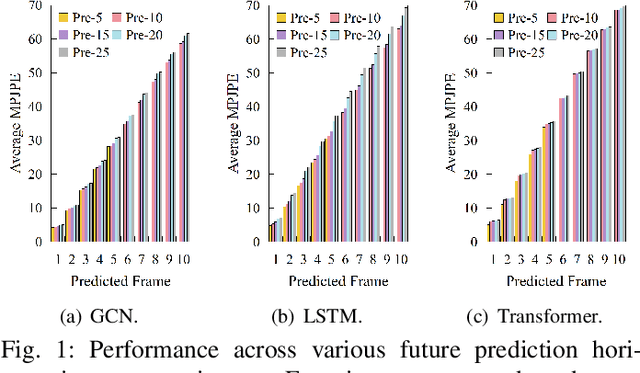
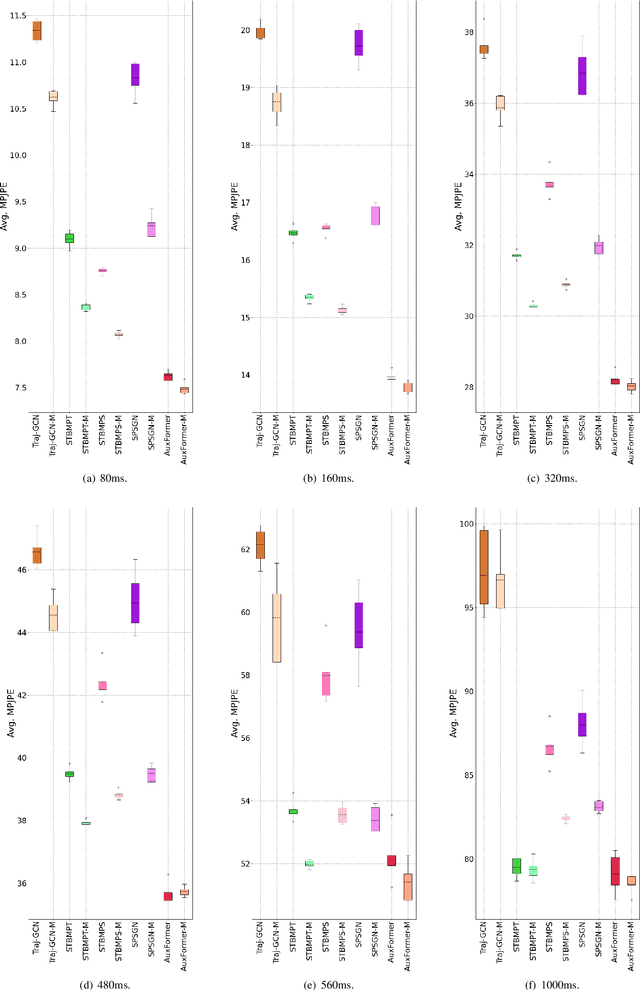
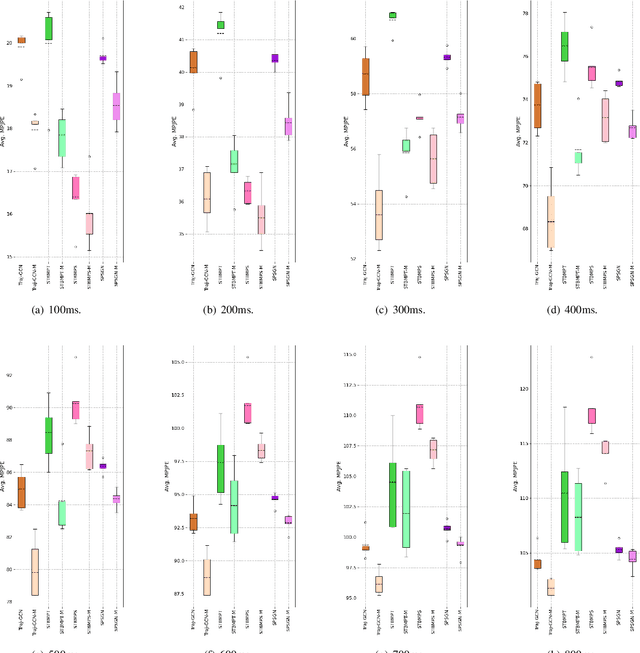
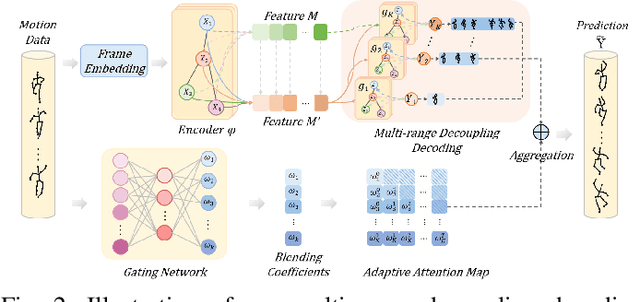
Abstract:Expressive representation of pose sequences is crucial for accurate motion modeling in human motion prediction (HMP). While recent deep learning-based methods have shown promise in learning motion representations, these methods tend to overlook the varying relevance and dependencies between historical information and future moments, with a stronger correlation for short-term predictions and weaker for distant future predictions. This limits the learning of motion representation and then hampers prediction performance. In this paper, we propose a novel approach called multi-range decoupling decoding with gating-adjusting aggregation ($MD2GA$), which leverages the temporal correlations to refine motion representation learning. This approach employs a two-stage strategy for HMP. In the first stage, a multi-range decoupling decoding adeptly adjusts feature learning by decoding the shared features into distinct future lengths, where different decoders offer diverse insights into motion patterns. In the second stage, a gating-adjusting aggregation dynamically combines the diverse insights guided by input motion data. Extensive experiments demonstrate that the proposed method can be easily integrated into other motion prediction methods and enhance their prediction performance.
Probabilistic Uncertain Reward Model: A Natural Generalization of Bradley-Terry Reward Model
Mar 28, 2025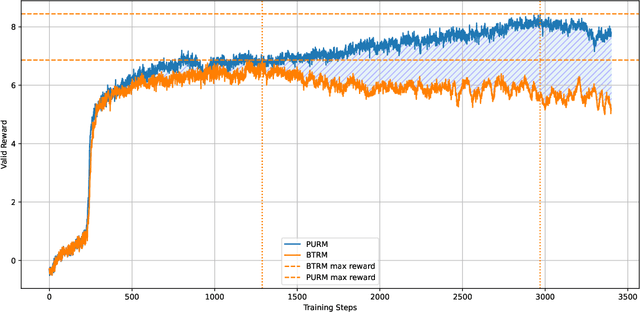
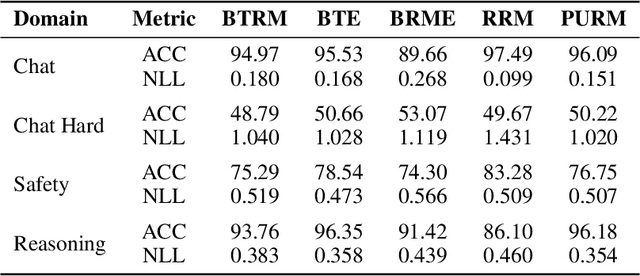
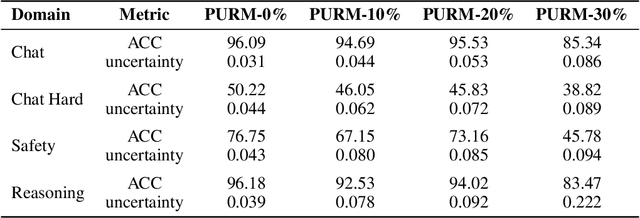
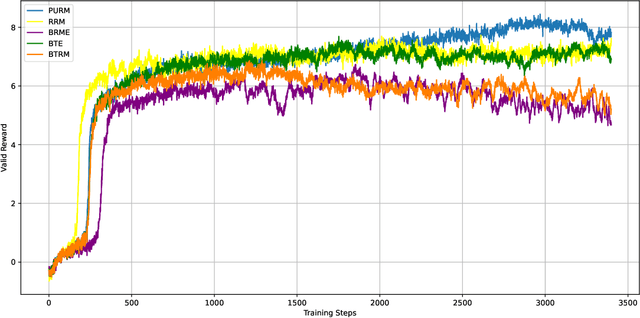
Abstract:Reinforcement Learning from Human Feedback (RLHF) has emerged as a critical technique for training large language models. However, reward hacking-a phenomenon where models exploit flaws in the reward model-remains a significant barrier to achieving robust and scalable intelligence through long-term training. Existing studies have proposed uncertain reward model to address reward hacking, however, they often lack systematic or theoretical foundations, failing to model the uncertainty intrinsically emerging from preference data. In this paper, we propose the Probabilistic Uncertain Reward Model (PURM), a natural generalization of the classical Bradley-Terry reward model. PURM learns reward distributions directly from preference data and quantifies per-sample uncertainty via the average overlap area between reward distributions. To mitigate reward hacking, we further introduce an uncertainty-aware penalty into Proximal Policy Optimization (PPO), which leverages the learned uncertainty to dynamically balance reward optimization and exploration. We propose a lightweight and easy-to-use implementation of PURM. Experiments demonstrate that PURM significantly delays the onset of reward hacking while improving final reward performance, outperforming baseline methods in both stability and effectiveness.
Regulatory DNA sequence Design with Reinforcement Learning
Mar 11, 2025Abstract:Cis-regulatory elements (CREs), such as promoters and enhancers, are relatively short DNA sequences that directly regulate gene expression. The fitness of CREs, measured by their ability to modulate gene expression, highly depends on the nucleotide sequences, especially specific motifs known as transcription factor binding sites (TFBSs). Designing high-fitness CREs is crucial for therapeutic and bioengineering applications. Current CRE design methods are limited by two major drawbacks: (1) they typically rely on iterative optimization strategies that modify existing sequences and are prone to local optima, and (2) they lack the guidance of biological prior knowledge in sequence optimization. In this paper, we address these limitations by proposing a generative approach that leverages reinforcement learning (RL) to fine-tune a pre-trained autoregressive (AR) model. Our method incorporates data-driven biological priors by deriving computational inference-based rewards that simulate the addition of activator TFBSs and removal of repressor TFBSs, which are then integrated into the RL process. We evaluate our method on promoter design tasks in two yeast media conditions and enhancer design tasks for three human cell types, demonstrating its ability to generate high-fitness CREs while maintaining sequence diversity. The code is available at https://github.com/yangzhao1230/TACO.
DualDiff+: Dual-Branch Diffusion for High-Fidelity Video Generation with Reward Guidance
Mar 05, 2025



Abstract:Accurate and high-fidelity driving scene reconstruction demands the effective utilization of comprehensive scene information as conditional inputs. Existing methods predominantly rely on 3D bounding boxes and BEV road maps for foreground and background control, which fail to capture the full complexity of driving scenes and adequately integrate multimodal information. In this work, we present DualDiff, a dual-branch conditional diffusion model designed to enhance driving scene generation across multiple views and video sequences. Specifically, we introduce Occupancy Ray-shape Sampling (ORS) as a conditional input, offering rich foreground and background semantics alongside 3D spatial geometry to precisely control the generation of both elements. To improve the synthesis of fine-grained foreground objects, particularly complex and distant ones, we propose a Foreground-Aware Mask (FGM) denoising loss function. Additionally, we develop the Semantic Fusion Attention (SFA) mechanism to dynamically prioritize relevant information and suppress noise, enabling more effective multimodal fusion. Finally, to ensure high-quality image-to-video generation, we introduce the Reward-Guided Diffusion (RGD) framework, which maintains global consistency and semantic coherence in generated videos. Extensive experiments demonstrate that DualDiff achieves state-of-the-art (SOTA) performance across multiple datasets. On the NuScenes dataset, DualDiff reduces the FID score by 4.09% compared to the best baseline. In downstream tasks, such as BEV segmentation, our method improves vehicle mIoU by 4.50% and road mIoU by 1.70%, while in BEV 3D object detection, the foreground mAP increases by 1.46%. Code will be made available at https://github.com/yangzhaojason/DualDiff.
IC-Mapper: Instance-Centric Spatio-Temporal Modeling for Online Vectorized Map Construction
Mar 05, 2025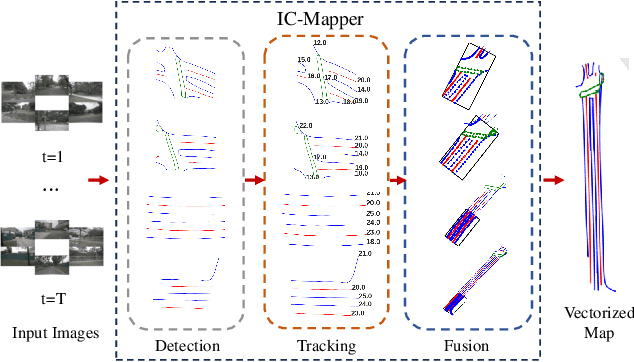
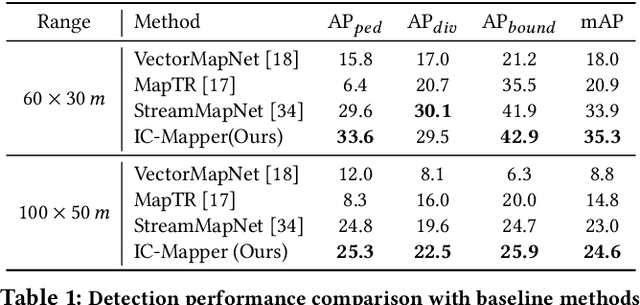

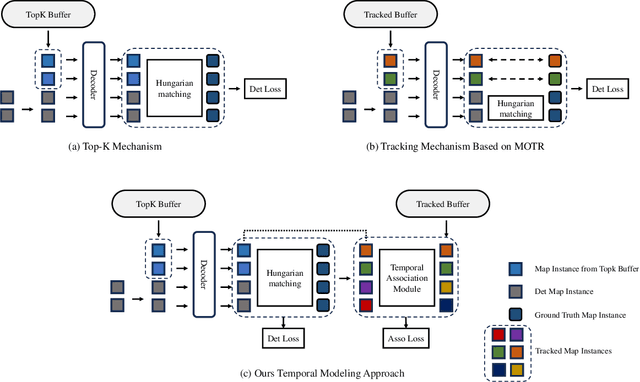
Abstract:Online vector map construction based on visual data can bypass the processes of data collection, post-processing, and manual annotation required by traditional map construction, which significantly enhances map-building efficiency. However, existing work treats the online mapping task as a local range perception task, overlooking the spatial scalability required for map construction. We propose IC-Mapper, an instance-centric online mapping framework, which comprises two primary components: 1) Instance-centric temporal association module: For the detection queries of adjacent frames, we measure them in both feature and geometric dimensions to obtain the matching correspondence between instances across frames. 2) Instance-centric spatial fusion module: We perform point sampling on the historical global map from a spatial dimension and integrate it with the detection results of instances corresponding to the current frame to achieve real-time expansion and update of the map. Based on the nuScenes dataset, we evaluate our approach on detection, tracking, and global mapping metrics. Experimental results demonstrate the superiority of IC-Mapper against other state-of-the-art methods. Code will be released on https://github.com/Brickzhuantou/IC-Mapper.
Diffusion Models for Tabular Data: Challenges, Current Progress, and Future Directions
Feb 24, 2025Abstract:In recent years, generative models have achieved remarkable performance across diverse applications, including image generation, text synthesis, audio creation, video generation, and data augmentation. Diffusion models have emerged as superior alternatives to Generative Adversarial Networks (GANs) and Variational Autoencoders (VAEs) by addressing their limitations, such as training instability, mode collapse, and poor representation of multimodal distributions. This success has spurred widespread research interest. In the domain of tabular data, diffusion models have begun to showcase similar advantages over GANs and VAEs, achieving significant performance breakthroughs and demonstrating their potential for addressing unique challenges in tabular data modeling. However, while domains like images and time series have numerous surveys summarizing advancements in diffusion models, there remains a notable gap in the literature for tabular data. Despite the increasing interest in diffusion models for tabular data, there has been little effort to systematically review and summarize these developments. This lack of a dedicated survey limits a clear understanding of the challenges, progress, and future directions in this critical area. This survey addresses this gap by providing a comprehensive review of diffusion models for tabular data. Covering works from June 2015, when diffusion models emerged, to December 2024, we analyze nearly all relevant studies, with updates maintained in a \href{https://github.com/Diffusion-Model-Leiden/awesome-diffusion-models-for-tabular-data}{GitHub repository}. Assuming readers possess foundational knowledge of statistics and diffusion models, we employ mathematical formulations to deliver a rigorous and detailed review, aiming to promote developments in this emerging and exciting area.
 Add to Chrome
Add to Chrome Add to Firefox
Add to Firefox Add to Edge
Add to Edge